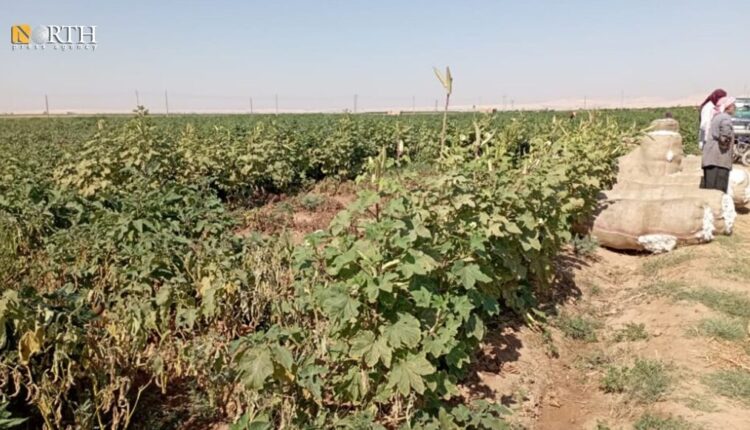Hassan a-Hamid, a farmer from Manbij in northern Syria, buys from time to time water tubes to connect them with his generator due to the reduction of the Euphrates River. Hassan does this to irrigate his field of cotton.
For Hassan, these are additional costs. Every time he moves the generator to come closer to the river to obtain enough water, the process causes breakdowns and more fuel consumption.
Hassan al-Hamid, 62, a farmer from the village of al-Shajara, 25 km south of Manbij, in Aleppo eastern countryside, planted his field with cotton this season.
The village of al-Shajara is located in the Tel Hozan area, south of Manbij. It is famous for planting cotton. There is a space of 250 hectares in the area all planted with cotton.
Cotton is one of the most strategic crops that are widely planted in northeast Syria. Syrian cotton is one of the best worldwide. Syria is one the most important countries in producing and planting cotton.
It is dubbed by farmers as “white gold.” However, the planted spaces have been reduced since 2012. In light of encouragement by the Autonomous Administration of North and East Syria (AANES) that opened centers to receive cotton, the crop has been recently reviving and extending.
Al-Hamid told North Press that his experience in planting cotton pushed him to increase the space this season. He has six hectares. However, he suffers from water reduction and rarity of fuels provided by the AANES’ Agriculture Committee in Manbij.
High costs
Al-Hamid added: “Water levels have receded from its banks some 300 meter away, this causes much more burdens regarding fuel. Our generator consumes a barrel and a half [330 liters], not to mention breakdowns in the generator.”
The farmers had additional expenditures to plant their field. They were obliged to buy fuels from the black market for their tractors, “plowing my land cost me two barrels of oil [440 liters], the Agriculture Committee gave us nothing.”
Al-Hamid lashed out at aid given by the Agriculture Committee, “They support agriculture, but this is not enough.”
Though al-Hamid sprayed insecticides on his cotton four times, it was to no avail, “The Agriculture Committee should deliver insecticides to farmers and run it. There are people that produce insecticides locally and put fake original trade marks on it,” according to al-Hamid.
The Agriculture Committee of the AANES warned of the spread of fake seeds and medicines produced and packed locally, “This was widely used with the corn.”
The farmer called on the Agriculture Committee to deliver fertilizers as merchants monopolize them, a 50kg sack of fertilizers was sold for $40, “The AANES is more lenient, we need the black fertilizer.”
Cotton is one of the crops that need much catering, manpower, spraying insecticides and fertilizers that make it one of the costly plants.
Transferring to Raqqa
In addition to what have been mentioned above, there remains the problem of transferring cotton from Manbij to Raqqa. It is the most difficult of all for al-Hamid due to the additional expenditures and the implied losses.
He harvests his crops and rents a truck for 300,000 SYP (about $65) to transfer the crop to Raqqa. In case the delivery of cotton delayed the car [drivers] asks more fees.
On September 5, the Agriculture Board of the AANES set the price of a kilogram of cotton at 4,300 SYP, saying the price set has a margin of profits near half of its costs.
At the end of August, the AANES allocated three centers to deliver cotton crops to. The Hasakah cotton mill, the 7km center in Deir ez-Zor and the cotton center in Raqqa.
Farmers could deliver their crops in line with a license given by the Agriculture Committees and Guidance Units to verify the origin of the product.
Workers harvesting cotton would be paid 3,000 SYP per kg, and 50,000 SYP for the car that transfers them daily, in addition to burlap sacks, where the farmers buy them for 22,000 SYP to fill them with cotton.
As al-Hamid, Manla al-Hamadi a famer from the same village suffers from the lack of fuels provided by the Agriculture Committee in Manbij and transferring the product to Raqqa that implies additional burdens.
Requirements of planting cotton are countless and all sold highly. The support given is “little” and it is has a kind of “austerity,” as he put it.
Al-Hamadi called for opening centers to deliver cotton in Manbij since it is an agrarian area to encourage the product and alleviate costs.
No solution
According to Abdul-hamid al-Hussein, an official of the Agrarian Guidance in Tel Hozan area, they are well informed on the problems and obstacles facing farmers due to the drought, waves of pesticides and the high prices of insecticides.
Al-Hussein said the price set for a kilogram of cotton is appeasing and encouraging to extend sown spaces.
Al-Hussein indicated that the Agriculture Committee in Manbij in coordination with Raqqa’s committee defined a day per week to receive cotton from Manbij farmers to facilitate delivery and avoid additional costs of transfer.
Al-Hussein did not propose any solutions for the plight of cotton farmers.

